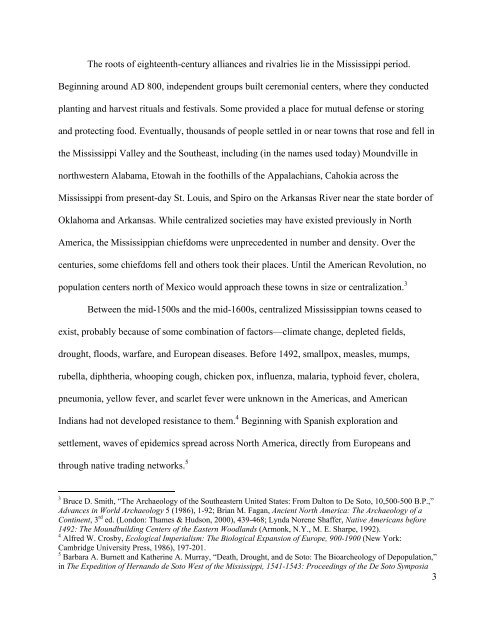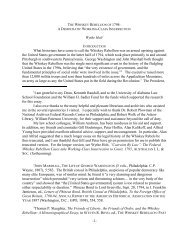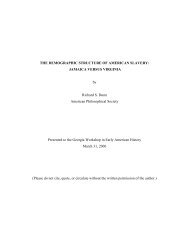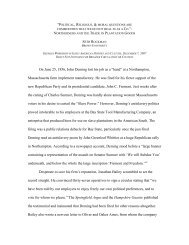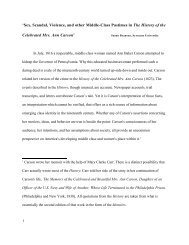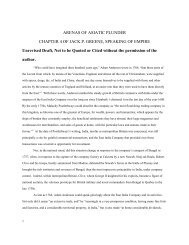Interconnectedness and Diversity in ?French Louisiana? - Georgia ...
Interconnectedness and Diversity in ?French Louisiana? - Georgia ...
Interconnectedness and Diversity in ?French Louisiana? - Georgia ...
Create successful ePaper yourself
Turn your PDF publications into a flip-book with our unique Google optimized e-Paper software.
The roots of eighteenth-century alliances <strong>and</strong> rivalries lie <strong>in</strong> the Mississippi period.<br />
Beg<strong>in</strong>n<strong>in</strong>g around AD 800, <strong>in</strong>dependent groups built ceremonial centers, where they conducted<br />
plant<strong>in</strong>g <strong>and</strong> harvest rituals <strong>and</strong> festivals. Some provided a place for mutual defense or stor<strong>in</strong>g<br />
<strong>and</strong> protect<strong>in</strong>g food. Eventually, thous<strong>and</strong>s of people settled <strong>in</strong> or near towns that rose <strong>and</strong> fell <strong>in</strong><br />
the Mississippi Valley <strong>and</strong> the Southeast, <strong>in</strong>clud<strong>in</strong>g (<strong>in</strong> the names used today) Moundville <strong>in</strong><br />
northwestern Alabama, Etowah <strong>in</strong> the foothills of the Appalachians, Cahokia across the<br />
Mississippi from present-day St. Louis, <strong>and</strong> Spiro on the Arkansas River near the state border of<br />
Oklahoma <strong>and</strong> Arkansas. While centralized societies may have existed previously <strong>in</strong> North<br />
America, the Mississippian chiefdoms were unprecedented <strong>in</strong> number <strong>and</strong> density. Over the<br />
centuries, some chiefdoms fell <strong>and</strong> others took their places. Until the American Revolution, no<br />
population centers north of Mexico would approach these towns <strong>in</strong> size or centralization. 3<br />
Between the mid-1500s <strong>and</strong> the mid-1600s, centralized Mississippian towns ceased to<br />
exist, probably because of some comb<strong>in</strong>ation of factors—climate change, depleted fields,<br />
drought, floods, warfare, <strong>and</strong> European diseases. Before 1492, smallpox, measles, mumps,<br />
rubella, diphtheria, whoop<strong>in</strong>g cough, chicken pox, <strong>in</strong>fluenza, malaria, typhoid fever, cholera,<br />
pneumonia, yellow fever, <strong>and</strong> scarlet fever were unknown <strong>in</strong> the Americas, <strong>and</strong> American<br />
Indians had not developed resistance to them. 4 Beg<strong>in</strong>n<strong>in</strong>g with Spanish exploration <strong>and</strong><br />
settlement, waves of epidemics spread across North America, directly from Europeans <strong>and</strong><br />
through native trad<strong>in</strong>g networks. 5<br />
3<br />
Bruce D. Smith, “The Archaeology of the Southeastern United States: From Dalton to De Soto, 10,500-500 B.P.,”<br />
Advances <strong>in</strong> World Archaeology 5 (1986), 1-92; Brian M. Fagan, Ancient North America: The Archaeology of a<br />
Cont<strong>in</strong>ent, 3<br />
3<br />
rd ed. (London: Thames & Hudson, 2000), 439-468; Lynda Norene Shaffer, Native Americans before<br />
1492: The Moundbuild<strong>in</strong>g Centers of the Eastern Woodl<strong>and</strong>s (Armonk, N.Y., M. E. Sharpe, 1992).<br />
4<br />
Alfred W. Crosby, Ecological Imperialism: The Biological Expansion of Europe, 900-1900 (New York:<br />
Cambridge University Press, 1986), 197-201.<br />
5<br />
Barbara A. Burnett <strong>and</strong> Kather<strong>in</strong>e A. Murray, “Death, Drought, <strong>and</strong> de Soto: The Bioarcheology of Depopulation,”<br />
<strong>in</strong> The Expedition of Hern<strong>and</strong>o de Soto West of the Mississippi, 1541-1543: Proceed<strong>in</strong>gs of the De Soto Symposia


